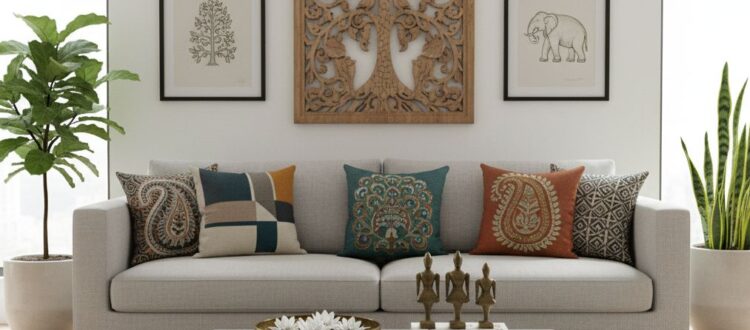Patterns with Purpose: Understanding Indian Decorative Arts Motifs
Have you ever gazed at a richly woven silk carpet with Indian traditional motifs, or an antique furniture with ornate carvings or a metal inlay work and felt a connection to something ancient, vibrant, and profound? This is the magic of Indian motifs and patterns that captivates you with a story and engages all your senses.
When you explore Indian decorative arts and the mythological Indian motifs that inhabit them, you’re entering a world where aesthetics meet meaning.
From the lotus motif to the peacock to paisley, each motif carries heritage, spirituality and design potential.
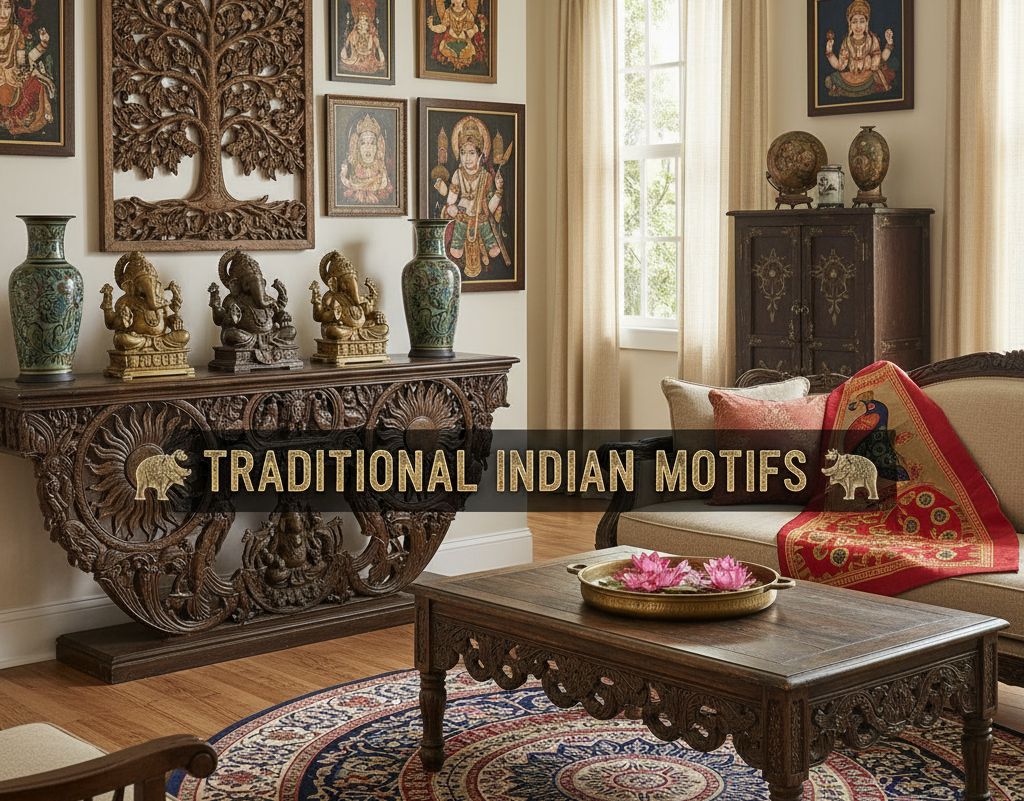
Also Read: Meaning of Motifs
Decorative Arts and Indian Décor Motifs Entwined
Decorative arts — think furniture, textiles, metalwork, ceramics, wall panels — have always been the canvas for motifs.
Take a moment to look around your living space. Is there a carpet with a paisley pattern? A wall hanging featuring an elephant? A small, symbolic piece of brassware? Indian home décor is filled with motifs and patterns that carry within themselves centuries of meaning and tradition.
Motifs are recurring shapes or symbols that carry meaning; they may reference myth, nature, philosophy, or culture. When motifs meet decorative arts, you get objects that are more than beautiful: they tell stories.
The true value of Indian decorative arts lies in this hidden meaning. When you understand the motifs, a simple object transforms into a spiritual guide, a token of prosperity, or a silent narrative of eternal love.
Indian Decorative Arts and Motifs
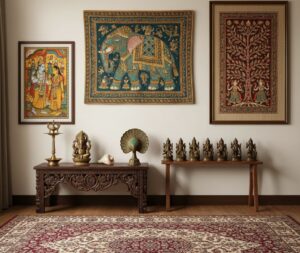
India’s decorative arts have long drawn on mythological and natural motifs. From the ancient era of the Indus Valley Civilization through temple architecture to modern artisan prints, motifs are found across various media.
https://www.youtube.com/watch?v=KM2taeVv6qQ
Video credit:
Sarmaya Arts Foundation
@SarmayaArtsFoundation
Beginner’s Guide to Understanding Indian Decorative Art Motifs
Walk into any Indian home, temple, or heritage craft bazaar, and you’ll find yourself surrounded by patterns — carved in wood, woven in silk, painted on walls, or cast in metal. These aren’t just pretty designs. They’re motifs — visual symbols with deep cultural, spiritual, and artistic meaning.
For anyone curious about Indian decorative arts and motif symbolism, understanding these motifs is the first step to appreciating centuries of craftsmanship.
- The Lotus
Lotus motifs appear extensively in Indian textiles, sculpture, painting and architecture, evoking divine presence and tranquillity.
Meaning: Purity, enlightenment, divine beauty.
Background: The lotus grows in muddy water but blooms untouched — symbolising purity of spirit and the triumph of the soul over materialism.
Found on: Temple carvings, paintings, brass lamps, cushion prints, and floor rangoli patterns.
Modern décor use: Lotus-motif wall art or cushions create a calm, spiritual focal point.
- The Peacock
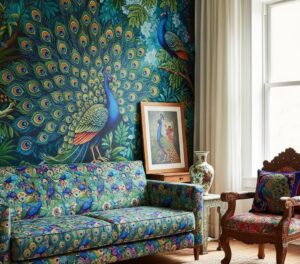
Meaning: Beauty, pride, immortality, love.
Background: The national bird of India, associated with Saraswati (goddess of knowledge) and Kartikeya (god of war). Its feathers represent divine protection and artistic beauty.
Found on: Embroidered textiles, murals, jewellery, and painted furniture. Indian folk art like Madhubani features paired peacocks to symbolise unity, romance and eternal love.
Modern décor use: Vibrant peacock motifs bring life and colour to upholstery or framed prints.
- The Paisley Motif
Meaning: Fertility, renewal, life’s continuity.
Background: Originating from Persian “boteh” designs, the mango-shaped paisley became a defining Indian textile motif.
Found on: Sarees, curtains, rugs and carpets, wallpapers, and upholstery.
Modern décor use: Paisley carpets, curtains, or rugs add heritage texture to modern interiors.
Also Read: Paisley Pattern Origin & Meaning
- Mandala Patterns
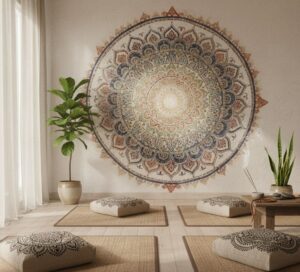
Mandala patterns explore the cosmos through their intricate detailing of radial, balanced geometric designs.
Meaning: Spiritual journey, order, wholeness.
Background: Mandalas reflect the cosmic order.
Found on: Paintings, rugs, murals, and temple architecture.
Modern décor use: Perfect as meditative wall art or rug designs.
- The Swastika
Meaning: Prosperity, good fortune, cosmic harmony.
Background: Ancient Indian symbol used for over 3,000 years, representing the sun and universal well-being (long before it was misused in the West).
Found on: Doors, thresholds, rituals, metal décor, and temple sculptures.
Modern décor use: Stylised geometric swastika forms in tiles or patterns carry auspicious energy.
- The Tree of Life
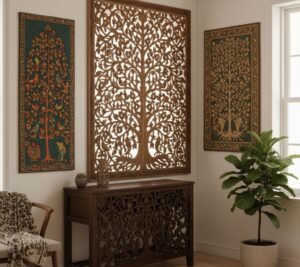
Meaning: Growth, eternity, interconnectedness.
Background: Found in Mughal miniatures, tribal art, and temple sculpture, it represents the link between heaven, earth, and the underworld.
Found on: Wooden screens, wall panels, paintings, and embroidered fabrics.
Modern décor use: Carved tree-of-life wall décor adds both symbolism and artistic flair.
- The Elephant
Elephants are associated with Ganesha, the remover of obstacles, and signify new beginnings and wisdom.
Meaning: Strength, wisdom, stability, royal power.
Background: Sacred to Lord Ganesha, elephants signify abundance and are frequent in temple and palace motifs.
Found on: Wooden chests, furniture carvings, sculptures, and block prints.
Modern décor use: A carved elephant table or wall hanging anchors any space with calm strength.
- The Serpent (Naga)
Meaning: Protection, rebirth, fertility.
Background: Mythological guardian figure linked to water, fertility, and divine energy.
Found on: Stone temple carvings, jewellery, tribal motifs.
Modern décor use: Abstract serpent shapes inspire modern metal or ceramic décor pieces.
- The Conch Shell (Shankha)
Meaning: Divine sound, purity, cosmic vibration.
Background: A sacred symbol in Hindu rituals, Vishnu carries the conch as a weapon of sound and energy.
Found on: Brass décor, temple motifs, and wall art.
Modern décor use: Coastal or spiritual homes use stylized conch shapes in lamps or sculptures.
- The Sun
Meaning: Power, vitality, eternal energy.
Background: Worshipped since the Vedic age, it represents Surya, the life-giver.
Found on: Metal plaques, temple carvings, rangoli, and furniture motifs.
Modern décor use: Golden sunburst wall décor remains timeless and radiant.
Decor Tips: Weaving Motifs into Your Modern Home
Integrating these powerful Indian motifs doesn’t mean transforming your house into a museum. The beauty is in the balance—creating a space that is both contemporary and culturally rich.
- The Statement Textile
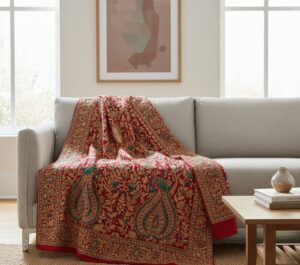
A single, high-quality textile can define a room. Drape a gorgeous, embroidered shawl with Paisley or Peacock motifs over a neutral sofa, or use a Kalamkari cloth with a Tree of Life pattern as a bold wall hanging.
- Auspicious Accents

Use symbolic figures as focal points. A pair of carved wooden Elephants flanking an entryway invites good fortune and strength. A brass bowl etched with Lotus flowers placed on a coffee table serves as a constant reminder of purity.
- Pattern Play
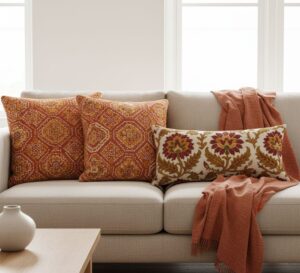
Don’t be afraid to mix patterns, a hallmark of Indian decor. Layer cushion covers with geometric Bandhani patterns alongside throws featuring large Floral Butas.
Giftex: A World of Collectibles Auction – The Hunt for History
For those who want to move beyond mass-produced items and invest in pieces with tangible history, auctions are the ultimate destination. The Giftex World of Collectibles Auction is a beacon for enthusiasts of vintage and antique decorative arts and furniture.
At an auction like Giftex, you don’t just acquire an object; you acquire an heirloom.
A Global Tapestry of Timeless Style
The enduring appeal of Indian motifs lies in their ability to transcend time and borders.
Indian decorative arts are a universe of motifs — visual keys to understanding the culture’s depth. Each line, curve, and colour tells a story: of gods and humans, of nature and spirit, of craftsmanship and continuity.
For beginners, learning these motifs opens the door to appreciating not just art, but the ideas behind it. Whether you’re decorating your home, collecting antiques, or simply curious about Indian design, let every motif remind you that beauty and meaning are meant to coexist.

